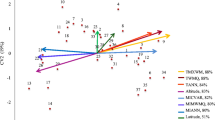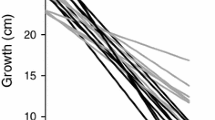Abstract
Environment and genetics combine to influence tree growth and should therefore be jointly considered when evaluating forest responses in a warming climate. Here, we combine dendroclimatology and population genetic approaches with the aim of attributing climatic influences on growth of European larch (Larix decidua) and Norway spruce (Picea abies). Increment cores and genomic DNA samples were collected from populations along a ~900-m elevational transect where the air temperature gradient encompasses a ~4 °C temperature difference. We found that low genetic differentiation among populations indicates gene flow is high, suggesting that migration rate is high enough to counteract the selective pressures of local environmental variation. We observed lower growth rates towards higher elevations and a transition from negative to positive correlations with growing season temperature upward along the elevational transect. With increasing elevation there was also a clear increase in the explained variance of growth due to summer temperatures. Comparisons between climate sensitivity patterns observed along this elevational transect with those from Larix and Picea sites distributed across the Alps reveal good agreement, and suggest that tree-ring width (TRW) variations are more climate-driven than genetics-driven at regional and larger scales. We conclude that elevational transects are an extremely valuable platform for understanding climatic-driven changes over time and can be especially powerful when working within an assessed genetic framework.






Similar content being viewed by others
References
Affolter P, Büntgen U, Esper J, Rigling A, Weber P, Luterbacher J, Frank D (2010) Inner Alpine conifer response to 20th century drought swings. Eur J For Res 129:289–298. doi:10.1007/s10342-009-0327-x
Allen CD, Macalady AK, Chenchouni H, Bachelet D, McDowell N, Vennetier M, Kitzberger T, Rigling A, Breshears DD, Hogg (Ted) EH, Gonzalez P, Fensham R, Zhang Z, Castro J, Demidova N, Lim J-H, Allard G, Running SW, Semerci A, Cobb N (2010) A global overview of drought and heat-induced tree mortality reveals emerging climate change risks for forests. For Ecol Manag 259:660–684. doi:10.1016/j.foreco.2009.09.001
Auer I, Böhm R, Jurkovic A, Lipa W, Orlik A, Potzmann R, Schöner W, Ungersböck M, Matulla C, Briffa K, Jones P, Efthymiadis D, Brunetti M, Nanni T, Maugeri M, Mercalli L, Mestre O, Moisselin J-M, Begert M, Müller-Westermeier G, Kveton V, Bochnicek O, Stastny P, Lapin M, Szalai S, Szentimrey T, Cegnar T, Dolinar M, Gajic-Capka M, Zaninovic K, Majstorovic Z, Nieplova E (2007) HISTALP—historical instrumental climatological surface time series of the Greater Alpine Region. Int J Climatol 27:17–46. doi:10.1002/joc.1377
Babst F, Poulter B, Trouet V, Kun T, Neuwirth B, Wilson R, Carrer M, Grabner M, Tegel W, Levanic T, Panayotov M, Urbinati C, Bouriaud O, Ciais P, Frank DC (2013) Site- and species-specific responses of forest growth to climate across the European continent. Global Ecol Biogeogr 22:706–717. doi: 10.1111/geb.12023
Bigler C, Veblen TT (2009) Increased early growth rates decrease longevities of conifers in subalpine forests. Oikos 118:1130–1138. doi:10.1111/j.1600-0706.2009.17592.x
Brohan P, Kennedy JJ, Harris I, Tett SFB, Jones PD (2006) Uncertainty estimates in regional and global observed temperature changes: a new data set from 1850. J Geophys Res 111:D12106. doi:10.1029/2005JD006548
Büntgen U, Frank DC, Schmidhalter M, Neuwirth B, Seifert M, Esper J (2005) Growth/climate response shift in a long subalpine spruce chronology. Trees 20:99–110. doi:10.1007/s00468-005-0017-3
Büntgen U, Bellwald I, Kalbermatten H, Schmidhalter M, Frank DC, Freund H, Bellwald W, Neuwirth B, Nusser M, Esper J (2006a) 700 years of settlement and building history in the Lotschental, Switzerland. Erdkunde 60:96–112
Büntgen U, Frank DC, Nievergelt D, Esper J (2006b) Summer Temperature Variations in the European Alps, a.d. 755–2004. J Clim 19:5606–5623. doi:10.1175/JCLI3917.1
Büntgen U, Tegel W, Nicolussi K, McCormick M, Frank D, Trouet V, Kaplan JO, Herzig F, Heussner K-U, Wanner H, Luterbacher J, Esper J (2011) 2500 years of european climate variability and human susceptibility. Science 331:578–582. doi:10.1126/science.1197175
Carrer M, Urbinati C (2006) Long-term change in the sensitivity of tree-ring growth to climate forcing in Larix decidua. New Phytol 170:861–872. doi:10.1111/j.1469-8137.2006.01703.x
CH2011 (2011) Swiss Climate Change Scenarios CH2011. C2SM, MeteoSwiss, ETH, NCCR Climate, and OcCC, Zürich
Cook ER (1985) A time series analysis approach to tree ring standardization. Dissertation, University of Arizona, Tucson
Courbaud B, Kunstler G, Morin X, Cordonnier T (2011) What is the future of the ecosystem services of the Alpine forest against a backdrop of climate change? J Alp Res 98-4. doi:10.4000/rga.1317
Donnelly A, Caffarra A, Kelleher CT, ONeill BF, Diskin E, Pletsers A, Proctor H, Stirnemann R, OHalloran J, Peuelas J, Hodkinson TR, Sparks TH (2012) Surviving in a warmer world: environmental and genetic responses. Clim Res 53:245–262. doi:10.3354/cr01102
Ebell IF, Schmidt RF (1964) Meteorological factors affecting conifer pollen dispersal on Vancouver Island. Publication 1036, Canadian Department of Forestry, Ottawa, Ontario
Eilmann B, Rigling A (2012) Tree-growth analyses to estimate tree species’ drought tolerance. Tree Physiol 32:178–187. doi:10.1093/treephys/tps004
Esper J, Büntgen U, Frank DC, Nievergelt D, Liebhold A (2007) 1200 years of regular outbreaks in alpine insects. Proc R Soc London Ser B 274:671–679. doi:10.1098/rspb.2006.0191
Excoffier L, Lischer HEL (2010) Arlequin suite ver 3.5: a new series of programs to perform population genetics analyses under Linux and Windows. Mol Ecol Resour 10:564–567. doi:10.1111/j.1755-0998.2010.02847.x
FAO (2010) Global forest resources assessment 2010. Food and Agriculture Organization of the United Nations, Rome
Frank D, Esper J (2005) Characterization and climate response patterns of a high-elevation, multi-species tree-ring network in the European Alps. Dendrochronologia 22:107–121. doi:10.1016/j.dendro.2005.02.004
Frank DC, Esper J, Raible CC, Büntgen U, Trouet V, Stocker B, Joos F (2010) Ensemble reconstruction constraints on the global carbon cycle sensitivity to climate. Nature 463:527–530. doi:10.1038/nature08769
Goldblum D (2010) The geography of white oak’s (Quercus alba L.) response to climatic variables in North America and speculation on its sensitivity to climate change across its range. Dendrochronologia 28:73–83. doi:10.1016/j.dendro.2009.07.001
Gugerli F, Sperisen C, Büchler U, Magni F, Geburek T, Jeandroz S, Senn J (2001) Haplotype variation in a mitochondrial tandem repeat of Norway spruce (Picea abies) populations suggests a serious founder effect during postglacial re-colonization of the western Alps. Mol Ecol 10:1255–1263. doi:10.1046/j.1365-294X.2001.01279.x
Hijmans RJ, Cameron SE, Parra JL, Jones PG, Jarvis A (2005) Very high resolution interpolated climate surfaces for global land areas. Int J Climatol 25:1965–1978. doi:10.1002/joc.1276
Hoffmann AA, Sgrò CM (2011) Climate change and evolutionary adaptation. Nature 470:479–485. doi:10.1038/nature09670
Holderegger R, Buehler D, Gugerli F, Manel S (2010) Landscape genetics of plants. Trends Plant Sci 15:675–683. doi:10.1016/j.tplants.2010.09.002
Holmes RL (1983) Computer-assisted quality control in tree-ring dating and measurement. Tree Ring Bull 43:69–78
IPCC (2007) Climate Change 2007: the physical science basis. Contribution of working group I to the fourth assessment report of the intergovernmental panel on climate change. Cambridge University Press, Cambridge
Isoda K, Watanabe A (2006) Isolation and characterization of microsatellite loci from Larix kaempferi. Mol Ecol Notes 6:664–666. doi:10.1111/j.1471-8286.2006.01291.x
Jump AS, Peñuelas J (2005) Running to stand still: adaptation and the response of plants to rapid climate change. Ecol Lett 8:1010–1020. doi:10.1111/j.1461-0248.2005.00796.x
Jump AS, Hunt JM, Peñuelas J (2006) Rapid climate change-related growth decline at the southern range edge of Fagus sylvatica. Glob Change Biol 12:2163–2174. doi:10.1111/j.1365-2486.2006.01250.x
Kagawa A, Sugimoto A, Maximov TC (2006) Seasonal course of translocation, storage and remobilization of 13C pulse-labeled photoassimilate in naturally growing Larix gmelinii saplings. New Phytol 171:793–804
Kawecki TJ, Ebert D (2004) Conceptual issues in local adaptation. Ecol Lett 7:1225–1241. doi:10.1111/j.1461-0248.2004.00684.x
Khasa PD, Newton CH, Rahman MH, Jaquish B, Dancik BP (2000) Isolation, characterization, and inheritance of microsatellite loci in alpine larch and western larch. Genome 43:439–448. doi:10.1139/g99-131
King G, Fonti P, Nievergelt D, Büntgen U, Frank D (2013) Climatic drivers of hourly to yearly tree radius variations along a 6 °C natural warming gradient. Agric For Meteorol 168:36–46. doi:10.1016/j.agrformet.2012.08.002
Körner C (2007a) Climatic treelines: conventions, global patterns, causes. Erdkunde 61:316–324. doi:10.3112/erdkunde.2007.04.02
Körner C (2007b) The use of “altitude” in ecological research. Trends Ecol Evol 22:569–574. doi:10.1016/j.tree.2007.09.006
Lynch M, Ritland K (1999) Estimation of pairwise relatedness with molecular markers. Genetics 152:1753–1766
McLachlan JS, Clark JS, Manos PS (2005) Molecular indicators of tree migration capacity under rapid climate change. Ecology 86:2088–2098. doi:10.1890/04-1036
Moser L, Fonti P, Büntgen U, Esper J, Luterbacher J, Franzen J, Frank D (2010) Timing and duration of European larch growing season along altitudinal gradients in the Swiss Alps. Tree Physiol 30:225–233. doi:10.1093/treephys/tpp108
Neuwirth B, Esper J, Schweingruber FH, Winiger M (2004) Site ecological differences to the climatic forcing of spruce pointer years from the Lötschental, Switzerland. Dendrochronologia 21:69–78. doi:10.1078/1125-7865-00040
Ohsawa T, Ide Y (2008) Global patterns of genetic variation in plant species along vertical and horizontal gradients on mountains. Glob Ecol Biogeogr 17:152–163. doi:10.1111/j.1466-8238.2007.00357.x
Parmesan C (2006) Ecological and evolutionary responses to recent climate change. Annu Rev Ecol Evol Syst 37:637–669. doi:10.1146/annurev.ecolsys.37.091305.110100
Pasho E, Camarero JJ, De Luis M, Vicente-Serrano SM (2011) Impacts of drought at different time scales on forest growth across a wide climatic gradient in north-eastern Spain. Agric For Meteorol 151:1800–1811. doi:10.1016/j.agrformet.2011.07.018
Paulsen J, Weber UM, Körner C (2000) Tree growth near treeline: abrupt or gradual reduction with altitude? Arct Antarct Alp Res 32:14–20
Peakall R, Smouse PE (2006) GENALEX 6: genetic analysis in Excel. Population genetic software for teaching and research. Mol Ecol Notes 6:288–295. doi:10.1111/j.1471-8286.2005.01155.x
Pfeiffer A, Olivieri AM, Morgante M (1997) Identification and characterization of microsatellites in Norway spruce (Picea abies K.). Genome 40:411–419. doi:10.1139/g97-055
Pluess AR (2011) Pursuing glacier retreat: genetic structure of a rapidly expanding Larix decidua population. Mol Ecol 20:473–485. doi:10.1111/j.1365-294X.2010.04972.x
Rossi S, Anfodillo T, Menardi R (2006) Trephor: a new tool for sampling microcores from tree stems. IAWA J 27:89
Savolainen O, Pyhäjärvi T, Knürr T (2007) Gene flow and local adaptation in trees. Annu Rev Ecol Evol Syst 38:595–619. doi:10.1146/annurev.ecolsys.38.091206.095646
Schweingruber FH (1996) Tree rings and environment dendroecology. Haupt, Switzerland
Scotti Magni, Paglia Morgante (2002) Trinucleotide microsatellites in Norway spruce (Picea abies): their features and the development of molecular markers. Theor Appl Genet 106:40–50. doi:10.1007/s00122-002-0986-1
Selkoe KA, Toonen RJ (2006) Microsatellites for ecologists: a practical guide to using and evaluating microsatellite markers. Ecol Lett 9:615–629. doi:10.1111/j.1461-0248.2006.00889.x
Swetnam TW, Allen CD, Betancourt JL (1999) Applied historical ecology: using the past to manage for the future. Ecol Appl 9:1189–1206. doi:10.2307/2641390
Tollefsrud MM, Sønstebø JH, Brochmann C, Johnsen Ø, Skrøppa T, Vendramin GG (2009) Combined analysis of nuclear and mitochondrial markers provide new insight into the genetic structure of North European Picea abies. Heredity 102:549–562. doi:10.1038/hdy.2009.16
Villalba R, Veblen TT, Ogden J (1994) Climatic influences on the growth of subalpine trees in the Colorado front range. Ecology 75:1450–1462. doi:10.2307/1937468
Visser ME (2008) Keeping up with a warming world; assessing the rate of adaptation to climate change. Proc R Soc Lond Ser B 275:649–659. doi:10.1098/rspb.2007.0997
Williams CG (2009) Conifer reproductive biology. Springer, Berlin
Wolkovich EM, Cook BI, Allen JM, Crimmins TM, Betancourt JL, Travers SE, Pau S, Regetz J, Davies TJ, Kraft NJB, Ault TR, Bolmgren K, Mazer SJ, McCabe GJ, McGill BJ, Parmesan C, Salamin N, Schwartz MD, Cleland EE (2012) Warming experiments underpredict plant phenological responses to climate change. Nature 485:494–497. doi:10.1038/nature11014
Wright S (1950) The genetical structure of populations. Anal Eugen 15:323–354. doi:10.1111/j.1469-1809.1949.tb02451.x
Acknowledgments
This work was funded in part by a Swiss National Science Foundation project (no. 121859, INTEGRAL) and NCCR Climate (DE-TREE). We thank: Andrea Plüss, Christoph Sperisen, Pim van der Knaap, Sabine Brodbeck, Daniela Csencsics, Tabea Turrini, Andreas Koller and Anja Gall for existing genetic data and processing the new samples in this study; Stefan Bechet, Anne Verstege, Daniel Nievergelt, Flurin Babst, Ulf Büntgen, Kerstin Treydte for helping with the collection and processing of tree-ring data; Ben Poulter for the gridded climate data; and all of the above for discussion.
Conflict of interest
The authors declare that they have no conflict of interest.
Author information
Authors and Affiliations
Corresponding author
Additional information
Communicated by Tim Seastedt.
Electronic supplementary material
Below is the link to the electronic supplementary material.
Rights and permissions
About this article
Cite this article
King, G.M., Gugerli, F., Fonti, P. et al. Tree growth response along an elevational gradient: climate or genetics?. Oecologia 173, 1587–1600 (2013). https://doi.org/10.1007/s00442-013-2696-6
Received:
Accepted:
Published:
Issue Date:
DOI: https://doi.org/10.1007/s00442-013-2696-6




